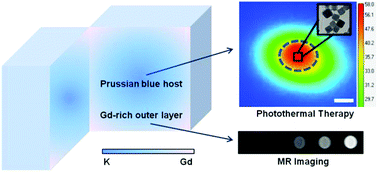One-step synthesis of gradient gadolinium ironhexacyanoferrate nanoparticles: a new particle design easily combining MRI contrast and photothermal therapy†
Abstract
A one-step synthesis of Prussian blue nanoparticles possessing a concentration gradient of Gd3+ counterions, g-Gd-PB, has been developed, and the potential for the particles to perform as both MRI positive contrast agents and photothermal therapy agents is demonstrated. The synthesis of potassium/gadolinium ironhexacyanoferrate is performed under increasing concentration of Gd3+ ions forming particles with a higher concentration of gadolinium toward the outer layers. The proton relaxivity (r1) measured for the particles is 12.3 mM−1 s−1, and T1 weighted images of phantoms containing the particles show their potential as MRI contrast agents. In addition, the Prussian blue host can rapidly and efficiently convert energy from near-IR light into thermal energy, allowing g-Gd-PB to be used as a photothermal therapy agent. The photothermal properties are demonstrated by measuring temperature changes of particle suspensions under irradiation and by photothermal ablation of CCRF-CEM cancer cells.


 Please wait while we load your content...
Please wait while we load your content...